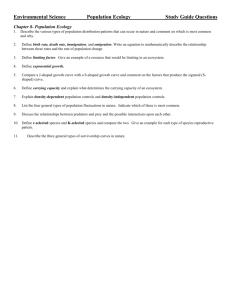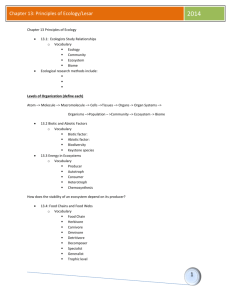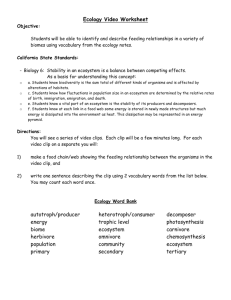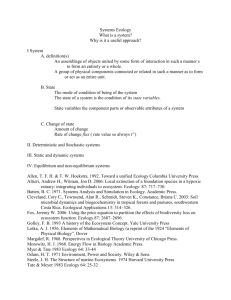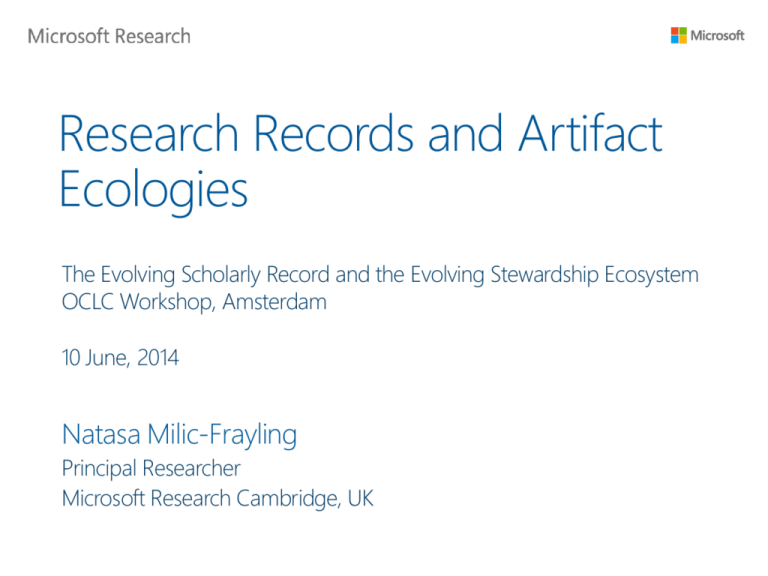
Research Records and Artifact
Ecologies
The Evolving Scholarly Record and the Evolving Stewardship Ecosystem
OCLC Workshop, Amsterdam
10 June, 2014
Natasa Milic-Frayling
Principal Researcher
Microsoft Research Cambridge, UK
Supporting Scientific Work
How to support reuse of scientific data,
tools, and resources to facilitate new
scientific discoveries?
Research on Scientific Practices (1)
Process of scientific discovery and ‘universalizing
knowledge’ is an inherently social enterprise
Van House, N. A., Butler, M. H., and Schiff, L. R. 1998. Cooperative knowledge
work and practices of trust: sharing environmental planning data sets. In Proc. of
CSCW '98. ACM Press (1998), 335-343
Ways of gathering and validating shared data bind the
researchers into distinct communities of practice
Birnholtz, J. P., and Bietz, M. J. Data at work: supporting sharing in science and
engineering. In Proc. of GROUP '03. ACM Press (2003), 339-348.
Research on Scientific Practices (2)
Gathering and propagation of scientific information
Difference between the scientific work conducted in the labs and reports
communicated to the scientific community.
Data passes through a complex, multi-stage social journey, from the
laboratory experiments to the written paper.
Latour, B. Science in Action, Harvard University Press, Cambridge MA, 1998.
Scientific records stands as an intermediary between the
raw data and the formal scientific paper
More ‘annotation, augmentation, deletion and imposed structure’ are
added to raw data, the more data moves towards record.
Shankar, K.,Order from chaos: The poetics and pragmatics of scientific recordkeeping.
J. Am. Soc. Inf. Sci. Technol. (2007) 58, 10, 1457-1466.
Research on Scientific Practices (3)
Collaboratories―enable teams of distributed scientists to
collaborate on scientific problems using tools for shared
data access, data analysis, and communication.
Olson et al. studied 10 major collaboratories and see them
as ‘a challenge to human organizational practices’.
Pre-specifying data sharing rules and having a clear understanding of
the common benefits, are essential for the success of a collaboratory.
Olson, G. M., Teasley, S., Bietz, M. J., and Cogburn, D. L. Collaboratories to support
distributed science: the example of international HIV/AIDS research. In Proc. of SAICSIT ‘02
(2002), 44-51.
Research on Scientific Practices (4)
Ownership of data and sharing
Bly [4] shows that scientists can be reluctant to share data for
fear of losing their ‘monopoly rent’ on that data.
Vertesi and Dourish found that the methods of producing and
acquiring data in the scientific collaboration influence the
manner in which the data is shared.
In collaborative and inter-dependent research, there is sense of group ownership
of data.
In more independent research, competing for equipment, time, and resources,
there is a feeling that data is personally earned and owned by individuals.
Bly, S. Special section on collaboratories, Interactions. ACM Press (1998), 5, 3, 31.
Vertesi, J. and Dourish, P. The value of data: considering the context of production in data
economies. In Proc. of CSCW '11, ACM Press (2011), 533-542.
Observations
Research has dealt with important factors:
Technical infrastructure (data repositories, tools)
Collaborative practices (sharing rules, adopting tools, etc.)
Information artifacts (scientific records including metadata
that contextualizes data, lab books, publications).
What is the inter-relationship of technologies,
practices, and artifacts that emerge as part of the
scientific activities.
Approach
Adopt the ecology metaphor, inspired by the
information ecology, introduced in 1999 by Nardi and
O’Day
Nardi B. A., and O'Day, V. L. Information ecologies: Using technology with heart.
(1999) MIT Press.
“Information Ecology is a system of people, practices,
values and technologies in a particular local
environment”.
Research Objectives
Study artifacts ecology of a successful collaborative
scientific environment
Understand the interdependencies of the technologies,
practices, and artifacts within the scientific discovery
Identify advantages and drawbacks of the observed
technologies and practices
Consider enhancements
Inform the design of the support required for collaborative
scientific work.
user observation study
SCIENTIFIC DISCOVERY IN THE NANOTECHNOLOGY LAB
University NanoPhotonics Research Centre
• Complex and dynamic research
environment
• Internationally recognized within
the highly competitive area
• Technologically highly advanced
Research in Optical Properties of Materials
Research Environment
Electronic Lab Book: HP
Tablets and MS OneNote
Sophisticated lab environment
Software:
OneNote
Office production tools
Igor analysis tool
Groove data sharing
Physical vs. Electronic Lab Book
Laboratory Notebook,
Yale University, 1946-1947,
p. 245 (June 19, 1946).
Physical vs. Electronic Lab Book
Observed Practices
Experiments and
data collection
Lab notebook
Analysis and
synthesis
Summary
Interpretation
and validation
• Work practices optimised for rapid sharing of data and
information with the research leader and the group
• Diverse digital artefact ecology, comprising material
samples, data, notes, and summaries
• Issues: bridge information silos, bridge the gap between
individual and collective record keeping.
Shared
notebook
Data Collection
Lab books
(OneNote Notebook)
Distillation―From Notes
to Summaries
Individual researcher notes
(OneNote Notebook)
Summary of findings
(PowerPoint slide)
Interpretation and
Validation
Gaining
collective
insights and
establishing
common
ground
Evolution of Knowledge & Digital Artefacts
Inter-weaving of Digital Artifacts
Uncovered complex nature of the artefact ecology
Scientific work produces a chain of interrelated and
complementary artifacts to enable interpretation of scientific
data
Artifacts are interrelated
Lab notes taken during experiments give context to the data
Summarise, from the notes, synthesize intermediary findings
During meetings, content from summaries (e.g., images) are embedded
into meeting notes.
Graphs and images are used and reused from one artefact to another,
contextualized in new ways as new interpretations emerge.
What does this all mean?
Providing access to data is a pre-requisite but not
sufficient to support successful reuse of scientific data.
We need to design rich environments that can give rise
to artifacts that facilitate interaction and crystalization of
experimental data and insights.
We need to maintain and share not only the data but
the artifact ecology that supports scientific work.
technology probe
REPRESENTATION OF RESEARCH PROJECTS
How to Create Overviews of Projects?
Linking artefacts
Overcome the
limitations of
physical
interaction
Meta Surfacing
Replace piles of papers with
iconic and digital representations
Enable search and data mining
Create conceptual maps for
individual topic, project, and
researcher, linking relevant
artefacts.
Enable rich interaction and real
time manipulation of maps and
objects.
Co-design Workshop
Representing information and data in shared resource maps
Co-design Workshop
Desire for improved information linking
• Space for viewing, arranging, annotating and creating
new links between data sources
• Collaborative space for making connections between
projects.
Co-design Workshop
Desire for visual project spaces
• Enable drill down from presentations and summaries
to raw data
• Support tagging and automatic data collection and
association
Visualization Ideas
Visualization Ideas
Support for Linking and Sense Making
Key functions
Platform
• Import any information type
• Microsoft Surface to help enable
• Enables annotation
• Enables linking of resources
• Link back to original file and folder place
collaboration
• Synchronisation between tablet and
Surface to support current practices
User Tasks
Sessions 1,2,3
Individual
knowledge
crystallisation
Session 4
Session 5
Collaborative
knowledge
crystallisation
Active review
Spatial Chunking of Maps
Sessions 1, S1
High level map
Commercial
work
Scientific
work
Progress
Most recent
data
Separate
scientific
work
Spatial Chunking and Linking within Maps
Sessions 2, S2
Blue – the results of
experiments on stretched
samples. Well understood
area.
Red – areas of uncertainty.
Nano-chasms and sample
cross sections are
incongruous. Results of
diffraction experiment not
understood. Solutions
needed.
Orange. Notes show illustrate
the interconnection and
dependencies between
different areas of the graph.
Project Maps
Project Maps
Learnings: Decoupling information
units from documents
• Participants imported sub-parts of the
documents.
• Extracting content was not fully supported
across file types; participants used
workarounds such as cut&paste
• The document file is too course grain for
creating project maps.
Learnings: Spatial and explicit
linking
• The participants used space, links, and
annotations to express relationships among
information items in the map.
• The semantic regions within the map could
be ambiguous to third parties without a
digital trace of interaction that led to the
map
Information Architecture
COMPOSITION
REFERENCES
COLLECTIONS
Information Architecture
COMPOSITION
REFERENCES
COLLECTIONS
long term access to digital
REPRESENTATION OF RESEARCH PROJECTS
FILE
APPLICATION
Persisted
DIGITAL
CONTENT/
EXPERIENCE
Ephemeral
PRESERVATION = Persistence + Connection with the contemporary ecosystem.
DIGITAL ARTEFACT
SOFTWARE – decoder
FILE – digital object
Persisted part of the digital artefact
Hardware to
process and
DISPLAY
Paradox: we are concerned about
storage, yet
Digital is inherently about processing bits,
not about storing bits
Symbiosis of Files and Applications
Objective of preservation is to ensure that the
persisted digital content and applications remain
connected with the contemporary computing
ecosystem.
PRESERVATION = Persistence + Connection with the contemporary ecosystem.
FILE
Persisted
APPLICATION
DIGITAL
CONTENT
Ephemeral
What do you want to keep ‘unchanged’?
FILE
APPLICATION
DIGITAL
CONTENT
• If application is not running in the contemporary
environment
What do you want to keep ‘unchanged’?
FILE
APPLICATION
DIGITAL
CONTENT
• If application is not running in the contemporary
environment
– Migrate files and run with a contemporary
software
(give up on both the original files and the application)
What do you want to keep ‘unchanged’?
FILE
APPLICATION
DIGITAL
CONTENT
• If application is not running in the contemporary
environment
– Retain the files and port the application to the
new environment
(retain content files by give up on the application, at least partially)
What do you want to keep ‘unchanged’?
FILE
APPLICATION
DIGITAL
CONTENT
• If application is not running in the contemporary
environment
– Create a virtual machine with the old computing
stack and run the original files and software.
(retain original files and original application; maintain scaffolding)
Computational Cradles
Sustain and increase the value of digtial
through
• Virtualization of legacy software +
Bridging Services
VM-Gen4
• Individual computational ‘cells’ for
different generations of software stacks
Bridging services: format
translators, content extractors,
etc.
Contemporary
Computing
Ecosystem
VM-Gen1
VM-Gen3
VM-Gen2
Connecting Legacy with
Contemporary Ecosystem
VM-Gen4
Contemporar
y Computing
Ecosystem
Digital artifact always requires (some software)
computation.
VM-Gen3
VM-Gen2
VM-Gen1
No need to give up on the original software!
Bridging Technologies and Methods
ICT: SOFTWARE AND HARDWARE INNOVATION
Contemporary Ecosystem
preserving computation
VIRTUALIZATION OF LEGACY SOFTWARE
Virtual Machine with Windows 2000 (left) and Windows XP (right), running on
Microsoft Cloud (Azure)
Start menus for Windows 2000 (left) and Windows XP (right),
MS Map Point application running on Windows 2000 (left) and MS Money 2003
running on Windows XP (right),
Increasing value of legacy content
FORMAT TRANSFORMATION
Word document shown in Microsoft Word 2.0 (from 1992)
Running in the Virtual Machine with Windows XP
Word document in MS Word 2.0 (from 1992) and converted to Open XML format,
shown in Office 2007 (right)
Word Perfect document, shown in WordPerfect 5.2 (from 1994)
Running in the Virtual Machine with Windows XP
Word Perfect document in WordPerfect 5.2 (from 1994) and converted to Open XML
format, shown in Office 2007 (right)
Concluding Remarks
Research results in a complex ecology of digital artefacts
This includes a computing infrastructure, software, and digital
artefacts
Snapshots of scientific research records can be
preserved through virtualization of the artefact ecology
That ensures that all the original artefacts can be accessed.
Services around research ecology snapshots can
provide added value.
These include curation services, beyond the project descriptions
provided by the specialist as part of research practices.
Thank you
Natasa Milic-Frayling
natasamf@microsoft.com
Integrated Systems
Microsoft Research Cambridge UK
©2013 Microsoft Corporation. All rights reserved.

